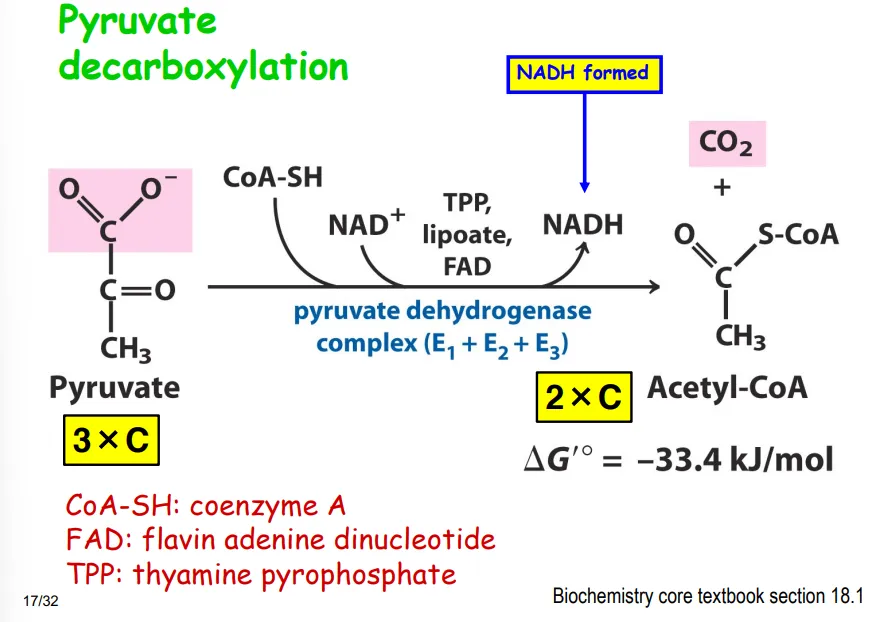Glycolysis, Link Reaction and Citric Acid Cycle
1/22
Earn XP
Description and Tags
These flashcards cover key terms and concepts related to glycolysis, the link reaction, and the citric acid cycle, emphasizing their regulation, key enzymes, and energy production.
Name | Mastery | Learn | Test | Matching | Spaced |
|---|
No study sessions yet.
23 Terms
hexokinase
An enzyme that catalyzes the phosphorylation of glucose to glucose-6-phosphate, inhibited by its product G6P.
glucokinase
found in the liver
catalyses phosphorylation of glucose to glucose-6-phosphate
not inhibited by G6P
Phosphofructokinase (PFK-1), activated and inhibited by what
The main regulatory enzyme in glycolysis
inhibited by ATP and citrate
activated by AMP and fructose-2,6-bisP.
what is PFK-1 activated by
low ATP/AMP ratio
fructose-2,6-bisP - feedforward activation
what inhibits PFK-1
high ATP - feedback inhibition
citrate
high H+ concentration
purpose of high H+ inhibiting PFK-1
glycolysis inhibition prevents accumulation of lactic acid
PFK-1 allosteric inhibition mechanism
tetramer PFK-1
ATP binds to regulatory site
slows reaction dramatically
Pyruvate Kinase
An enzyme that catalyzes the conversion of phosphoenolpyruvate to pyruvate, regulated by ATP and fructose-1,6-bisphosphate.
Feedback Inhibition
A method of metabolic control whereby the end product of a metabolic pathway inhibits an earlier step.
Acetyl-CoA
produced from pyruvate in aerobic conditions
thioester
high energy of hydrolysis
contains adenine, ribose and phosphates
Allosteric Enzyme
An enzyme with multiple binding sites that can be regulated by molecules that bind to sites other than the active site.
Covalent Modification
A process involving the addition or removal of a molecule, such as phosphate, to regulate enzyme activity.
phosphorylated form of pyruvate kinase
protein kinase at ser12
enzyme becomes les active
pyruvate decarboxylation
acetyl is converted to coa to create coenzyme coa (factor)
catalysed by pyruvate dehydrogenase complex
NADH is formed (2 electrons from pyruvate are transferred)
one co2 is released

what enzyme is used in pyruvate decarboxylation
pyruvate dehydrogenase complex
E1 - in charge of decarboxylation
E2 - role is to transfer acetyl group to CoA
E3 - in charge of cofactor regeneration
where is pyruvate dehydrogenase found in eukaryotes
mitochondrial matrix
pyruvate/H+ symporter allows transportation of pyruvate through inner membrane
first stage of citric acid cycle
Two carbon atoms (Acetyl-CoA) enter the cycle
Two different carbon atoms are oxidized
Two molecules of CO2 are released
Two molecules of NAD+ are reduced to NADH
Succinyl-CoA is formed (energy rich thioester)
second stage of citric acid cycle
Succinyl-CoA is hydrolyzed
Succinate is oxidized in 3 steps to Oxaloacetate
One molecule of GTP or ATP is formed
One CH2 group is oxidized to a C=O group
One molecule of FAD is reduced to FADH2
One molecule of NAD+ is reduced to NADH
breakdown of energy per nadh, fadh and per glucose
Each NADH ≃ 2.5 ATP
Each FADH2 ≃ 1.5 ATP
for each glucose 30-32 ATP produced
advantage of glucose-6-phosphate
cannot pass through the membrane to the extracellular side
what ion does hexokinase require
mg 2+
divalent cation is needed to form complex with ATP
citric acid entire cycle
acetylcoa joins with oxaloacetate
citrate → isocitrate
isocitrate decarboxylated → alpha-ketoglutarate NADH IS FORMED, CO2 RELEASED
alpha-ketoglutarate decarboxylated → succinyl-CoA NADH IS FORMED, CO2 RELEASED
succinyl-CoA → succinate , GTP or ATP FORMED
dehydrogenation of succinate → fumarate FADH2 FORMED
hydration and dehydrogenation of fumarate → malate ANOTHER NADH IS FORMED
oxalacetate is formed and cycle continues
for each acetyl coa which enters the cycle what are the products
two molecules of co2 are released
3 NADH
FAD
GTP/ATP